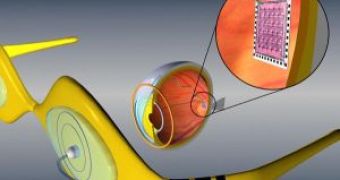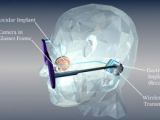We are stepping into the era of science-fiction technologies very fast. The first advanced "bionic eyes" have been implanted in the UK at the Moorfields Eye Hospital in London, during two successful surgeries.
The pioneering bionic eye comprises a wireless video camera and transmitter mounted on a pair of glasses. The minicamera transmits images to a cellphone-sized computer in the patient's pocket. This wireless computer transmits the processed images to an electronic minireceiver implanted behind the retina which transforms them into electrical impulses to the ganglion cells and through the optic nerve, to the brain's visual cortex. This process is extremely speedy, so the patient perceives the images in real-time; otherwise, the "vestibular-ocular reflex" would trigger dizziness and sickness.
The patient can see rudimentary black and white images of motion, light and darkness. These surgeries are part of an international clinical trial of the technology, called Argus II retinal implant, which has already proven successful in restoring rudimentary vision in American patients who became blind because of age-related macular degeneration or retinitis pigmentosa, a hereditary disease.
"The camera is very, very small, and very low power, so it can go inside your eye and couple your eye movement to where the camera is. With the kind of missing information the brain can fill in, this field is really blossoming," said Mark Humayun, Professor of Ophthalmology and Biomedical Engineering at the Doheny Eye Institute in Los Angeles, California, that also developed the technology.
"The devices were implanted successfully in both patients and they are recovering well from the operations. It is very special to be part of a program developing a totally new type of treatment for patients who would otherwise have no chance of visual improvement," said Lyndon da Cruz, the consultant retinal surgeon and part of the surgery team.
The American team wishes to develop a camera as large as a pea, that could later be implanted inside the eyeball. This could turn into reality within the next 3 to 5 years. "When I go to the grandkids' hockey game or soccer game I can see which direction the game is moving in. I can shoot baskets with my grandson, and I can see my granddaughter dancing across the stage," Linda Moorfoot, one of a few American patients fitted with the current type of implant and who had been blind for 10 years, told Sky News.
Moorfoot's implant has just 16 electrodes but the British patients received a higher-performance type, with 60 electrodes, that delivers clearer images. The producing company is also developing an implant with 1,000 electrodes, which would allow facial recognition. Indeed, this is just the beginning.
"The general public should not run away with the idea that this is going to be routine surgery for blind people in the immediate future because there is an enormous amount to learn," said John Marshall, of St Thomas' Hospital in London, and the British Retinitis Pigmentosa Society.

 14 DAY TRIAL //
14 DAY TRIAL // 
